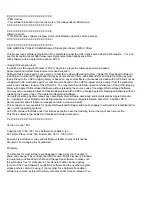
Combining high-performance architecture with high-performance Xeon processors
Please see the Legal Information section for important notices and information.
8
front LED indicates an error condition, by pressing a button on the front of the server an LED
panel will pop out and drop down for easy viewing
without the need to open the server cover
or
remove the server from the rack. The light path diagnostics panel tells the servicer which
component requires attention. In addition, many components have their own identifying LEDs.
For example, each of the memory modules has an LED next to the socket, as do all processors,
all adapter slots, all fans, all power supplies, all voltage regulator modules and the service
processor, allowing the servicer to easily identify exactly which component needs servicing. By
following the “light path,” the component can be replaced quickly, and without guesswork. (
Note:
In the event of a failed DIMM, the system will restart and mark the DIMM as bad while offline,
thus allowing the system to continue running, with reduced memory capacity, until serviced.)
In addition to the outstanding diagnostic detection, there is a new feature with a digital readout
that indicates at what stage of the boot process your system may have experienced trouble.
This can reduce the troubleshooting time and help get your system up and running quickly and
efficiently.
Other Features
•
Trusted Platform Module standard
— This module provides a highly secure start-up
process from power-on through hand-off to the operating system boot loader. ACPI support is
provided to allow ACPI-enabled operating systems to access the security features of this
module. (TCG V1.2-compliant.)
•
Six USB 2.0 ports
— Provides flexibility to add high-speed external devices. The USB 2.0
specification supports up to 480Mbps transfer rates. (Note: Not all USB 2.0 devices are
capable of achieving this rate.)
Two
ports are provided on the front of the server,
three
are
on the back, and
one
is internal to support the embedded
4GB USB 2.0 Flash Memory Key
in selected models.
•
Remote Supervisor Adapter II standard
— This full-function systems management adapter
provides local and remote management functions in a dedicated PCI-X slot, without
consuming one of the seven PCIe adapter slots.
•
Video
— An
ATI Radeon ES1000
SVGA video controller on the Remote Supervisor Adapter
II provides up to
1024x768
resolution, with a color depth of
32
bits at
85Hz
refresh rate, with
16MB of video memory.
•
Toolless slides
— Allows quick rack installation and quicker upgrade and servicing of the
server.
•
Toolless chassis
— The cover can be opened without tools, and many components can be
removed and replaced without tools, including the CD-RW/DVD combo drive, hot-add/hot-
swap memory, hot-swap HDDs, adapters, and the integrated optional ServeRAID-MR10k
and Remote Supervisor Adapter II. This can save a servicer significant time.
Rack Cable Management and KVM Console Switching
IBM Advanced Cabling Technology (
ACT
) is an optional feature that offers many advantages
over standard KVM cabling across the entire System x and xSeries product line. So now you
can interconnect all of your servers with one smart cabling architecture. ACT cabling eliminates
the need for one-to-one direct connections between each server and a KVM switch by using a
daisy-chain approach.
The snarl of cabling behind most racks is at best inconvenient to work around and at worst an
expensive logistical nightmare, requiring the rewiring of servers, PDUs, KVM switches, and
other equipment whenever a rack server is added or removed. Even worse, the veil of cables
blocks rack airflow and can actually contribute to equipment failure due to overheating. ACT
cabling is the solution for reducing behind-the-rack cabling by as much as
87%
.
Conventional cabling has bulky KVM cables exiting each server, which then connect to a KVM
switch. The cables exiting a series of KVM switches must then be aggregated via additional
KVM switches and PDUs, which only increases the number—and cost—of cables, KVM
switches and PDUs. Instead, the daisy-chain approach of ACT cabling uses readily available,
inexpensive CAT5 and 6 cabling to considerably
reduce
the number of cables, KVM switches,
and PDUs needed, rather than increasing them. If a server is removed or added, no complicated
rewiring is needed. One cable connects the first server in the rack to the next, and so on. Up to
16
servers form a chain; up to
8
chains can connect to one Local Console Manager (LCM);
16
LCMs can connect to one Global Console Manager (GCM). In this manner, up to
2,048
servers
can be centrally managed. Equally importantly, with ACT—unlike some other offerings—
everything is done externally via cabling;
no
special adapters are required.
The illustration below shows a sample ACT configuration:





































